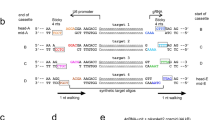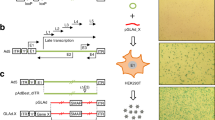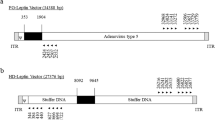Abstract
Helper-dependent adenovirus vectors (hdAd), which are deleted of all viral protein-coding sequences, can mediate long-term expression of a therapeutic transgene and lead to life-long, phenotypic correction in animal models of genetic disease. Here, we describe a new system for the generation of hdAd, which utilizes the DNA size restrictions imposed on an Ad virion deleted of protein IX (pIX): such virions are reported to package up to only ∼35 kb of viral DNA. A pIX− helper virus (∼37.3 kb) was easily grown on complementing 293pIX cells. Upon infection of noncomplementing cells, this virus was not capable of forming infectious virions, but provided replicative and packaging functions for propagation of a 30-kb hdAd. The pIX− helper virus was effective in amplifying an hdAd and, in combination with Cre-mediated excision in the viral-packaging signal, resulted in a 1000-fold reduction in helper virus contamination in hdAd stocks compared to Cre/lox alone, as determined by plaque assay. However, through slot blot analysis of DNA isolated from virions, we determined that the ratio of hdAd to helper DNA was 500:1, similar to the ratio observed when using Cre/lox alone. Surprisingly, a large amount of the 37.3-kb helper DNA was being packaged into the pIX-deleted virions, but these virions were incapable of establishing productive infections in plaque assays, for reasons which are still unclear. Nevertheless, the pIX− hdAd generated in this system infected cells and expressed a transgene at levels similar to those obtained with a pIX+ hdAd. These data suggest that, although further studies are necessary to characterize the nature of the defective helper virions formed in this system, deletion of pIX from the helper virus genome does provide an effective method to prevent recovery of functional helper virus during hdAd amplification.
This is a preview of subscription content, access via your institution
Access options
Subscribe to this journal
Receive 12 print issues and online access
$259.00 per year
only $21.58 per issue
Buy this article
- Purchase on Springer Link
- Instant access to full article PDF
Prices may be subject to local taxes which are calculated during checkout






Similar content being viewed by others
References
Amalfitano A, Parks RJ . Separating fact from fiction: assessing the potential of modified adenovirus vectors for use in human gene therapy. Curr Gene Ther 2002; 2: 111–133.
Schiedner G et al. Genomic DNA transfer with a high-capacity adenovirus vector results in improved in vivo gene expression and decreased toxicity. Nat Genet 1998; 18: 180–183.
Morsy MA et al. An adenoviral vector deleted for all viral coding sequences results in enhanced safety and extended expression of a leptin transgene. Proc Natl Acad Sci USA 1998; 95: 7866–7871.
Morral N et al. High doses of a helper-dependent adenoviral vector yield supraphysiological levels of alpha1-antitrypsin with negligible toxicity. Hum Gene Ther 1998; 9: 2709–2716.
Morral N et al. Administration of helper-dependent adenoviral vectors and sequential delivery of different vector serotype for long-term liver-directed gene transfer in baboons. Proc Natl Acad Sci USA 1999; 96: 12816–12821.
Hardy S et al. Construction of adenovirus vectors through Cre-lox recombination. J Virol 1997; 71: 1842–1849.
Ng P et al. Development of an FLP/frt system for generating helper-dependent adenoviral vectors. Mol Ther 2001; 3: 809–815.
Parks RJ et al. A helper-dependent adenovirus vector system: removal of helper virus by Cre-mediated excision of the viral packaging signal. Proc Natl Acad Sci USA 1996; 93: 13565–13570.
Umana P et al. Efficient FLPe recombinase enables scalable production of helper-dependent adenoviral vectors with negligible helper-virus contamination. Nat Biotechnol 2001; 19: 582–585.
Zhou H et al. A Cre-expressing cell line and an E1/E2a double-deleted virus for preparation of helper-dependent adenovirus vector. Mol Ther 2001; 3: 613–622.
Barjot C et al. Gutted adenoviral vector growth using E1/E2b/E3-deleted helper viruses. J Gene Med 2002; 4: 480–489.
Oka K et al. Long-term stable correction of low-density lipoprotein receptor-deficient mice with a helper-dependent adenoviral vector expressing the very low-density lipoprotein receptor. Circulation 2001; 103: 1274–1281.
Kim IH et al. Lifetime correction of genetic deficiency in mice with a single injection of helper-dependent adenoviral vector. Proc Natl Acad Sci USA 2001; 98: 13282–13287.
Morral N et al. Immune responses to reporter proteins and high viral dose limit duration of expression with adenoviral vectors: comparison of E2a wild type and E2a deleted vectors. Hum Gene Ther 1997; 8: 1275–1286.
McCoy RD et al. Pulmonary inflammation induced by incomplete or inactivated adenoviral particles. Hum Gene Ther 1995; 6: 1553–1560.
Stillman IE et al. Adenoviral gene therapy leads to rapid induction of multiple chemokines and acute neutrophil-dependent hepatic injury in vivo. Hum Gene Ther 1999; 10: 965–976.
Bett AJ, Prevec L, Graham FL . Packaging capacity and stability of human adenovirus type 5 vectors. J Virol 1993; 67: 5911–5921.
Parks RJ, Graham FL . A helper-dependent system for adenovirus vector production helps define a lower limit for efficient DNA packaging. J Virol 1997; 71: 3293–3298.
Boulanger P et al. Characterization of adenovirus protein IX. J Gen Virol 1979; 44: 783–800.
Colby WW, Shenk T . Adenovirus type 5 virions can be assembled in vivo in the absence of detectable polypeptide IX. J Virol 1981; 39: 977–980.
Ghosh-Choudhury G, Haj-Ahmad Y, Graham FL . Protein IX, a minor component of the human adenovirus capsid, is essential for the packaging of full length genomes. EMBO J 1987; 6: 1733–1739.
Caravokyri C, Leppard KN . Constitutive episomal expression of polypeptide IX (pIX) in a 293-based cell line complements the deficiency of pIX mutant adenovirus type 5. J Virol 1995; 69: 6627–6633.
Krougliak V, Graham FL . Development of cell lines capable of complementing E1, E4, and protein IX defective adenovirus type 5 mutants. Hum Gene Ther 1995; 6: 1575–1586.
Parks RJ, Evelegh CM, Graham FL . Use of helper-dependent adenoviral vectors of alternative serotypes permits repeat vector administration. Gene Therapy 1999; 6: 1565–1573.
Bridge E, Ketner G . Redundant control of adenovirus late gene expression by early region 4. J Virol 1989; 63: 631–638.
Grable M, Hearing P . cis and trans requirements for the selective packaging of adenovirus type 5 DNA. J Virol 1992; 66: 723–731.
Graham FL, Smiley J, Russell WC et al. Characteristics of a human cell line transformed by DNA from human adenovirus type 5. J Gen Virol 1977; 36: 59–74.
Chen L, Anton M, Graham FL . Production and characterization of human 293 cell lines expressing the site-specific recombinase Cre. Somat Cell Mol Genet 1996; 22: 477–488.
Kaufman RJ, Sharp PA . Construction of a modular dihydrofolate reductase cDNA gene: analysis of signals utilized for efficient expression. Mol Cell Biol 1982; 2: 1304–1319.
Berkner KL, Sharp PA . Effect of the tripartite leader on synthesis of a non-viral protein in an adenovirus 5 recombinant. Nucleic Acids Res 1985; 13: 841–857.
Chartier C et al. Efficient generation of recombinant adenovirus vectors by homologous recombination in Escherichia coli. J Virol 1996; 70: 4805–4810.
He TC et al. A simplified system for generating recombinant adenoviruses. Proc Natl Acad Sci USA 1998; 95: 2509–2514.
Hubberstey AV, Pavliv M, Parks RJ . Cancer therapy utilizing an adenoviral vector expressing only E1A. Cancer Gene Ther 2002; 9: 321–329.
Parks RJ et al. Effects of stuffer DNA on transgene expression from helper-dependent adenovirus vectors. J Virol 1999; 73: 8027–8034.
Ng P et al. Cre levels limit packaging signal excision efficiency in the Cre/loxP helper-dependent adenoviral vector system. J Virol 2002; 76: 4181–4189.
Acknowledgements
We thank Robert A Meulenbroek, Marta Pavliv, and Uma Sankar for their excellent technical assistance. This research was supported by funds provided by the Canadian Institutes of Health Research (RJP and FLG), Canadian Institute of Health Research/Muscular Dystrophy Association of Canada/Amyotrophic Lateral Sclerosis Society of Canada Partnership Grant (RJP), Premier's Research Excellence Award (RJP), National Institutes of Health (FLG), and the National Cancer Institute of Canada (FLG) and a research grant provided by Merck Research Laboratories (FLG). RJP is a Canadian Institutes of Health New Investigator.
Author information
Authors and Affiliations
Rights and permissions
About this article
Cite this article
Sargent, K., Ng, P., Evelegh, C. et al. Development of a size-restricted pIX-deleted helper virus for amplification of helper-dependent adenovirus vectors. Gene Ther 11, 504–511 (2004). https://doi.org/10.1038/sj.gt.3302107
Received:
Accepted:
Published:
Issue Date:
DOI: https://doi.org/10.1038/sj.gt.3302107
Keywords
This article is cited by
-
Self-inactivating helper virus for the production of high-capacity adenoviral vectors
Gene Therapy (2011)
-
Evaluation of adenovirus capsid labeling versus transgene expression
Virology Journal (2010)
-
Adenovirus Virion Stability and the Viral Genome: Size Matters
Molecular Therapy (2009)
-
Gutless adenovirus: last-generation adenovirus for gene therapy
Gene Therapy (2005)



